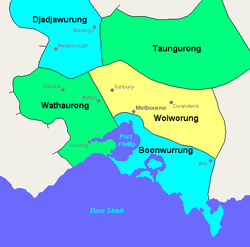The Taungurung people, also spelt Daung Wurrung, are an Aboriginal people who are one of the Kulin nations in present-day Victoria, Australia. They consist of nine clans whose traditional language is the Taungurung language.[1]

Their Country is to the north of the Great Dividing Range in the watersheds of the Broken, Delatite, Coliban, Goulburn and Campaspe Rivers. They lived to the north of, and were closely associated with, the Woiwurrung speaking Wurundjeri people.
They were also known by white settlers as the Devil's River Tribe or Goulburn River Tribe.[2]
Clan structure
editThe Taungurung have two moieties (kinship groups) covering nine distinct clans, each of which belonged to the Bunjil (Eaglehawk) moiety (five clans) or the Waang (Crow) moiety (four clans).[3]
Bunjil moiety
- Buthera balug[a], located in the Upper Goulburn area near Yea and Seymour.
- Moomoom Gundidj, around the Campaspe and north-west of Mitchellstown
- Warring-illum[b] balug around the Upper Goulburn River, Yea and Alexandra.
- Yarran Illam, in the area of the Goulburn river below Seymour.
- Yeerun-Illam around Benalla.
Waang moiety
- Look (w)illam around the Campaspe River near Kilmore
- Nattarak balug is associated with the Coliban and Upper Campaspe Rivers.
- Nira balug adjacent to Wurundjeri country, encompassing hilly terrain near Kilmore, Broadford, Pyalong, Mount Macedon and Heathcote.
- Yowung-Illam balug, associated with Alexandra, Mansfield and the Upper Goulburn River.[3]
History
editThe Taungurung people used the King and Howqua River valleys as a major route for trade or war between tribes.[4] The Howqua River valley contains a number of archaeological sites of significance including at least two quarry sites for greenstone, an exceptionally hard rock used for stone axes, spears and other cutting tools which the Taungurung traded with other tribes. There are many other significant cultural both tangible and in tangible across their country.[5]
A raiding party of up to 40 Taungurung is believed to have been killed in May–June 1839 on Dja Dja Wurrung territory at the Campaspe Plains massacre.[6]
In February 1859 some Wurundjeri elders, led by Simon Wonga (aged 35) and brother Tommy Munnering (aged 24) petitioned Protector William Thomas to secure land on behalf of the Taungurung clans for the Kulin at the junction of the Acheron and Goulburn rivers in Taungurung territory. Initial representations to the Victorian Government were positive, however the intervention of the most powerful squatter in Victoria, Hugh Glass, resulted in their removal to a colder site, Mohican Station, which was not suitable for agricultural land and had to be abandoned.[1][7]
In March 1863 after three years of upheaval, the surviving leaders, among them Simon Wonga and William Barak, led forty Wurundjeri, Taungurung (Goulburn River) and Boonwurrung people over the Black Spur and squatted on a traditional camping site on Badger Creek near Healesville and requested ownership of the site. This became Coranderrk Station.[7]
The Taungurung Clans Aboriginal Corporation was registered as a Registered Aboriginal Party by the Victorian Aboriginal Heritage Council on 16 July 2009.[8]
Notes
edit- ^ balug is a suffix indicating a number of people (Patterson & Jones 2020, p. 13).
- ^ -illam meant a dwelling place
Citations
edit- ^ a b Broome 2005, pp. 123–125.
- ^ Presland 1985, pp. 45–46.
- ^ a b Patterson & Jones 2020, p. 13.
- ^ Alpine National Park Management Plan 1992, p. 68.
- ^ Alpine National Park Management Plan 1992, p. 69.
- ^ Attwood 1999, pp. 7–9.
- ^ a b Ellender & Christiansen 2001, pp. 112–113.
- ^ Department of Premier and Cabinet 2009.
Sources
edit- "Alpine National Park Management Plan" (PDF). Department of Conservation and Environment. September 1992. Archived from the original (PDF) on 31 March 2012.
- Attwood, Bain (1999). "My Country. A history of the Djadja Wurrung 1837-1864". Monash Publications in History. 25: 7–9. ISSN 0818-0032.
- Barwick, Diane E. (1984). McBryde, Isabel (ed.). "Mapping the past: an atlas of Victorian clans 1835-1904". Aboriginal History. 8 (2): 100–131. JSTOR 24045800.
- Broome, Richard (2005). Aboriginal Victorians: A History Since 1800. Allen & Unwin. pp. 123–125. ISBN 1-74114-569-4.
- Clark, Ian D. (1995). Scars in the Landscape: a register of massacre sites in western Victoria, 1803–1859 (PDF). AIATSIS. pp. 57–84. ISBN 0-85575-281-5.
- Ellender, Isabel; Christiansen, Peter (2001). People of the Merri Merri. The Wurundjeri in Colonial Days. Merri Creek Management Committee. pp. 112–113. ISBN 0-9577728-0-7.
- Patterson, Roy Henry; Jones, Jennifer (2020). On Taungurung Land: Sharing History and Culture. Australian National University Press. ISBN 978-1-760-46407-3.
- Presland, Gary (1985). Aboriginal Melbourne: The Lost Land of the Kulin People (Second ed.). Harriland Press. pp. 45–46. ISBN 0-9577004-2-3.
- "Taungurung Clans Aboriginal Corporation". Department of Premier and Cabinet. 16 July 2009. Archived from the original on 14 October 2016. Retrieved 24 May 2016.